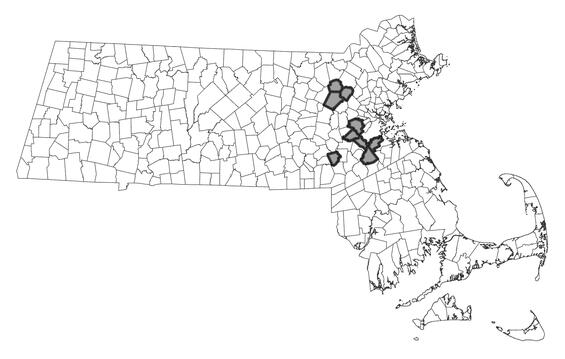- Scientific name: Viola brittoniana Pollard
- Species of Greatest Conservation Need (MA State Wildlife Action Plan)
- Threatened (MA Endangered Species Act)
Description
Britton’s violet (Viola brittoniana) is a low-growing, herbaceous perennial found within or at the edges of floodplains of freshwater rivers. It has variably dissected leaves and purple flowers that bloom from the middle of May to early June.
Britton’s violet grows 5 to 10 inches (12–25 cm) in height and has basal leaves arising directly from a rhizome. Two varieties of Britton’s violet (and their hybrids) are currently recognized and protected here: V. brittoniana var. brittoniana and V. brittoniana var. pectinata. (Some authors consider these taxa separate species; this question is currently under evaluation by NHESP). The nominate variety has consistently dissected leaves, usually deeply dissected into three lobes; the center lobe is usually further divided into three sublobes, and the lateral ones into three or four sublobes. In V. brittoniana var. pectinata, the leaves are narrowly to (increasingly through the season) broad-triangular and uncut but with long-toothed margins, especially toward the base. In both varieties, closed, self-fertilizing (cleistogamous) flowers appear above ground but below the taller leaves during June and July. Fruits produced from both flower types are similar, round to ovoid dark tan capsules that become upright and split into three parts when mature. Forcible ejection of the seeds has been observed up to 3 m (9 ft) from the plant. Seeds are further dispersed by ants.
Similar species
Several other violets occur intermingled with or near Britton’s violet populations. Bird’s foot violet (V. pedata) is the only other species with deeply dissected leaves. In this species, leaves are divided into as many as 15 narrow segments. Leaves of other violets with purple flowers have different leaf morphology: Marsh blue violet (V. cucullata) has heart-shaped unlobed leaves; early blue violet (V. palmata) has shallowly-lobed leaf sinuses; arrow-leaved violet (V. sagittata) has oblong to triangular leaves often with only basal lobes; woolly blue violet (V. sororia) has kidney-shaped leaves. The nominate variety of Britton’s violet is known to hybridize with marsh blue violet, wooly blue violet and arrow-leaved violet; hybrids have unlobed early-season leaves and lobed later-season leaves.
Population status
Britton’s violet is listed under the Massachusetts Endangered Species Act as threatened. All listed species are legally protected from killing, collection, possession, or sale, and from activities that would destroy habitat and thus directly or indirectly cause mortality or disrupt critical behaviors. Britton's violet has 15 occurrences that have been verified since 1999 in Middlesex and Norfolk Counties. Historically, it also occurred in Plymouth and Suffolk Counties.

Distribution in Massachusetts
1999-2024
Based on records in the Natural Heritage Database
Distribution and abundance
Britton's violet has a limited range which extends from Massachusetts south to the Carolinas. It is considered critically imperiled in Connecticut, Massachusetts, New York and Pennsylvania, imperiled in North Carolina, vulnerable in Virginia, apparently secure in Delaware and Maryland, and not ranked in New Jersey or South Carolina.
Habitat
In Massachusetts, Britton’s violet is found mostly between the upper part of the annually flooded zone and the 100-year flood line of freshwater rivers. The U.S. Fish and Wildlife Service classifies it as a facultative wetland species (FAC), indicating that it occurs equally often in wetland or upland areas of the floodplain. The wetlands are generally wet meadows. This terrestrial species occurs in two distinct habitats in Massachusetts: within mowed areas and along woodland trails (generally whose edges are occasionally mowed or cleared). The species is rare in Massachusetts because most of the suitable habitat has been altered by fill for development, floodplain diking, or conversion to or from agriculture.
Healthy habitats are vital for supporting native wildlife and plants. Explore habitats and learn about conservation and restoration in Massachusetts.
Threats
Threats to Britton’s violet include disruptions to the natural hydrologic regime, changes in water quality due to sedimentation, trampling, and over-shading or competition from aggressive native and exotic invasive species. Glossy buckthorn (Frangula alnus) is an exotic invasive species of particular concern at Britton’s violet habitat locations.
Conservation
Management
As with many rare species, the exact management needs of Britton’s violet are unknown. This species apparently does not compete well in successional areas; germination occurs in recently disturbed areas, but plants die out as taller native and exotic species become established. Successful management may include periodic mechanical removal of dense competing vegetation and targeted treatment for particularly insidious invasive species. All active management of rare plant populations (including invasive species removal) should be planned in consultation with the Massachusetts Natural Heritage & Endangered Species Program to avoid inadvertent damage to rare species.
References
Ballard, Harvey E., John T. Kartesz and Misako Nishino. “A taxonomic treatment of the violets (Violaceae) of the A taxonomic treatment of the violets (Violaceae) of the northeastern United States and adjacent Canada” in Journal of the Torrey Botanical Society 150(1): 3–266, 2023.
Gleason, Henry A., and Arthur Cronquist. Manual of Vascular Plants of Northeastern United States and Adjacent Canada, Second Edition. Bronx, NY: The New York Botanical Garden, 1991.
Haines, A. 2011. Flora Novae Angliae – a Manual for the Identification of Native and Naturalized Higher Vascular Plants of New England. New England Wildflower Society, Yale Univ. Press, New Haven, CT.
NatureServe. 2025. NatureServe Network Biodiversity Location Data accessed through NatureServe Explorer [web application]. NatureServe, Arlington, Virginia. Available https://explorer.natureserve.org/. Accessed: 6/3/2025.
POWO (2025). Plants of the World Online. Facilitated by the Royal Botanic Gardens, Kew. Published on the Internet; https://powo.science.kew.org/ Accessed: 6/3/2025.
Contact
| Date published: | April 15, 2025 |
|---|